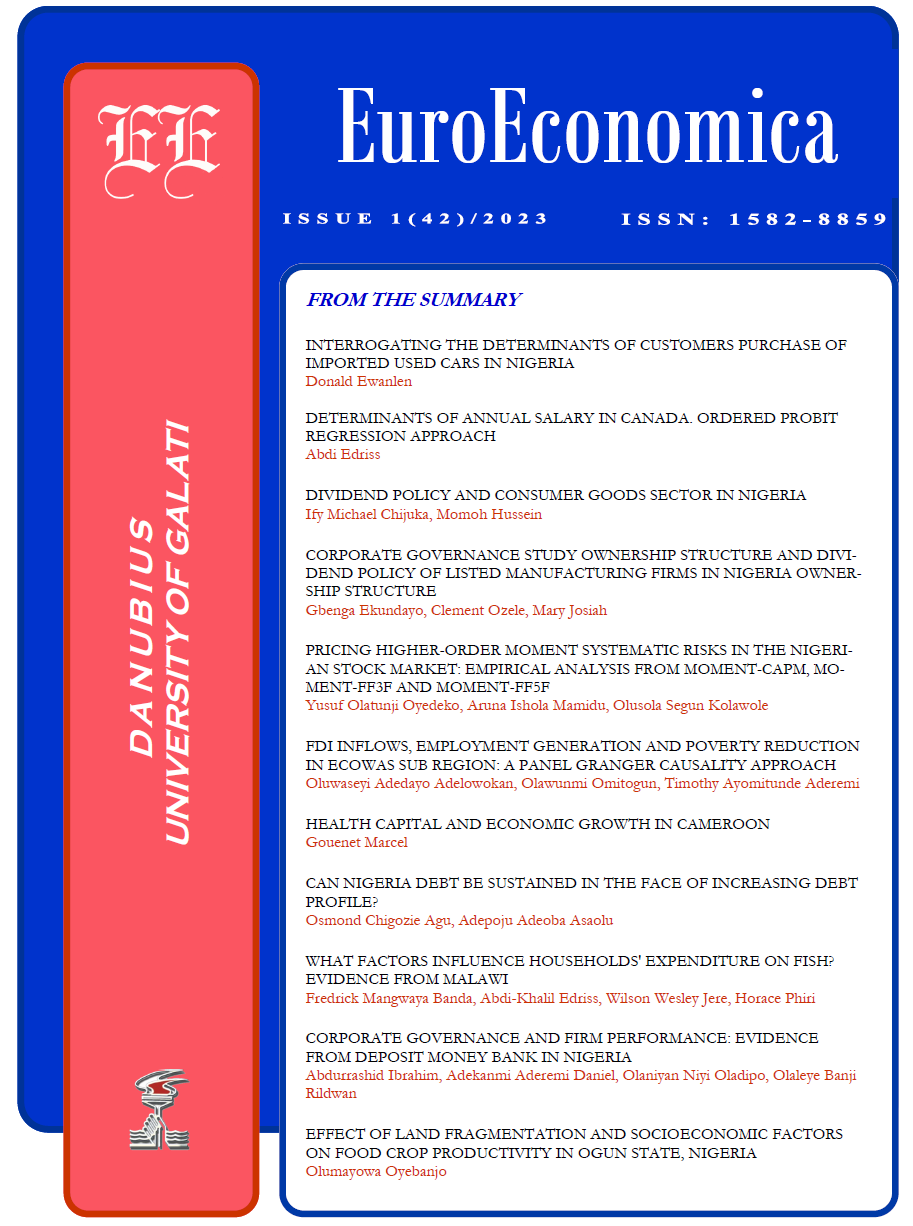Pricing Higher-Order Moment Systematic Risks in the Nigerian Stock Market: Empirical Analysis from Moment-CAPM, Moment-FF3F and Moment-FF5F.
Abstract
The purpose of this study is to explore the effect of higher-order moment systematic risks on stock return using Moment-CAPM, Moment-FF3F and Moment-FF5F in the Nigerian stock market. The study sample 90 stocks listed on the Nigerian Group of Exchange as at December 2020. The study covered the period of January 2005 to December 2020 and Fama-MacBeth regression was used as the estimation technique. Evidence from the result showed that coskewness risk has positive significant effect on return under the three-moment factor CAPM, four-moment FF3F and six-moment FF5F. This implies that the coskewness risk is significantly priced in the Nigerian stock market and this means that coskewness risk command premium. Also, this result was supported with the fact that the introduction of coskewness risk significantly improves the explanatory powers of the standard CAPM, FF3F and FF5F models. However, it was revealed that the cokurtosis risk has positive significant effect on return under the seven-moment FF5F but the cokurtosis risk has positive insignificant effect on return under three-moment factor CAPM, four-moment FF3F. In view of this, the study concluded that higher moment systematic risks are also determinants of asset return in the Nigerian stock market which must be taken into consideration in risk-return decision making process. Thus, the study recommends that in the process of making investment decision, the investors should maintain positive skewness risk factor because it will increase the expected return and negative kurtosis which has positive effect on stock return.
References
Adaramola, A. O., Oyedeko, Y.O. (2022). Effect of drawdown strategy on risk and return in Nigerian stock market. Financial Markets, Institutions and Risks, 6(3), 70-81. http://doi.org/10.21272/fmir.6(3).70-81.2022
Aggarwal, R., Rao, R. P., & Hiraki, T. (1989). Skewness and kurtosis in Japanese equity returns: Empirical evidence. The Journal of Financial Research, 12, 253–260.
Ajibola, A., Kunle, O. A. & Prince, N. C. (2015). Empirical proof of the CAPM with higher
order co-moments in Nigerian Stock Market: The conditional and unconditional based
tests. Journal of Applied Finance and Banking, 5(1), 151-162.
Beedles, W. L. (1986). Asymmetry in Australian equity returns. Australian Journal of
Management, 11(1), 1–12.
Bester, J. (2016). Higher moment asset pricing on the JSE (Master dissertation, University of the
Witwatersand, South Africa). http://hdl.handle.net/10539/20495
Black I., Jensen, M.C., & Scholes, M. (1972). The capital asset pricing model: Some empirical
tests in Jensen M.C ed studies in the theory of capital markets. Praeger Publishers, New
York 79-121
Chamadia, S., Rehman, M. U., & Kashif, M. (2021) Do average higher moments predict
aggregate returns in emerging stock markets? Journal of Asian Business and Economic
Studies 29(2), 120-145.
Elyasiani, E., Gambarelli, L., & Muzzioli, S. (2018). Moment risk premia and the cross-section
of stock returns. Department of Economics, University of Modena and Reggio Emilia,
Italy, DEMB Working Paper Series N. 103
Gbadebo, A. O. & Oyedeko, Y. O. (2021). Economic risk factors and expected return: Evidence
from upside and downside market conditions in Nigeria. Theoretical and Empirical
Researches in Urban Management, 16(2), 72-88.
Iglesias, G. E. (2017). Higher moments risk and the cross-section of returns (Master dissertation,
Universidad Complutense, País). www.finanzascuantitativas.com
Lal, I., Mubeen, M., Hussain, A. & Zubair, M. (2016). An empirical analysis of higher moment
capital asset pricing model for Karachi Stock Exchange (KSE). Open Journal of Social
Sciences, 4, 53-60. http://dx.doi.org/10.4236/jss.2016.46006
Lintner, J. (1965). The valuation of risk assets and selection of risky investments in stock
portfolios and capital budgets. Review of Economics and Statistics, 47, 13-37.
Lux, T. & Marchesi, M. (2000). Volatility clustering in financial markets: A microsimulation of
interacting agents. International Journal of Theoretical and Applied Finance, 03,
–702.
Man, N. D. (2017). The impact of higher moments on the stock returns of listed companies in
Vietnam. Banking Technology Review 2(2), 221-238.
Mossin, J. (1969). Security pricing and investment criteria in competitive markets. American
Economic Review, 59, 739-56.
Naqvi, B., Mirza, N., Naqvi, W. A., & Rizvi, S. K. A. (2017). Portfolio optimisation with higher
moments of risk at the Pakistan Stock Exchange. Economic Research-Ekonomska
Istraživanja, 30(1), 1594–1610 https://doi.org/10.1080/1331677X.2017.1340182
Oyedeko, Y. O., Zubairu, M., & Samson, R. (2021). Is Covid-19 risk significantly priced in the
Nigerian stock market? Evidence from one-two-three-factor capital asset pricing model.
Fuoye Journal of Finance and Contemporary Issue, 1(1), 134-143.
Roll, R. (1977). A critique of the asset pricing theory’s tests; part I: On past and potential
testability of the theory. Journal of Financial Economics, 4(2) 129-176.
Ross, S.A. (1976). The arbitrage theory of capital asset pricing. Journal of Economic Theory,
(6) 341-360.
Sharpe, W.F. (1964). Capital asset prices: A theory of market equilibrium under conditions of
risk. Journal of Finance, 19, 425-442
Tol, P. V. (2015). Relevance of higher moments in explaining stock return of growth and value
stocks (Master Dissertation , Erasmus University, Rotterdam, Netherlands).
Vendrame, V., Guermat, C. & Tucker, J. (2022). A conditional higher-moment CAPM.
Electronic copy available at: https://ssrn.com/abstract=4240502
Zhong, A. (2017). Idiosyncratic volatility in the Australian equity market, Pacific-Basin
Finance Journal. https//doi.org/10.1016/j.pacfin.2017.06.010
Zubairu M. & Oyedeko, Y. O. (2017). Santa Claus rally and Nigerian stock market return: An
illusion or reality? Net Journal of Business Management, 5(1), 1-5.
Downloads
Published
How to Cite
Issue
Section
License
Copyright (c) 2023 Yusuf Oyedeko

This work is licensed under a Creative Commons Attribution-NonCommercial 4.0 International License.
The author fully assumes the content originality and the holograph signature makes him responsible in case of trial.


